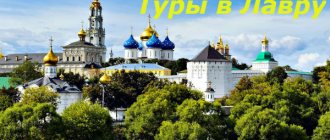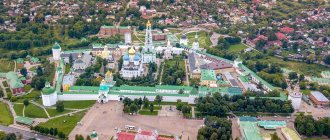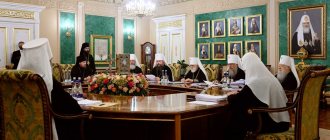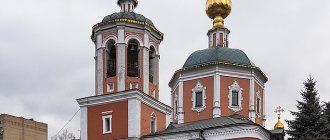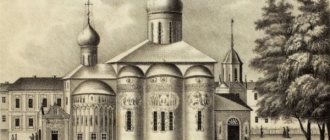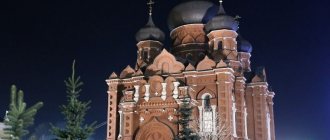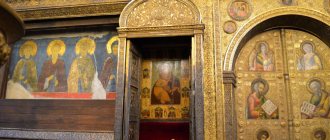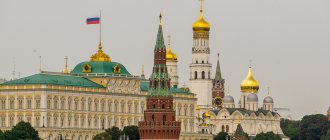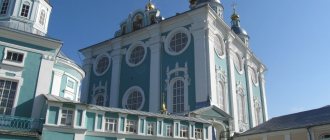We came here to the Trinity-Sergius Lavra as absolutely inexperienced visitors, so it is not surprising that we got the impression that the most important temple here is the Assumption. Many people make this mistake. However, this is not at all surprising. After all, when laying the foundation for this cathedral in 1559, the mighty, frantic and mysterious Ivan the Terrible planned to create not just a temple, but a grandiose temple, eclipsing others with its beauty and grandeur.
I even thought, over time, to transfer the relics of Sergius of Radonezh to it. However, he soon abandoned his plan. The terrible king became timid, fearing the wrath of the saint, and did not dare to touch his relics. Well, if only something had frightened the Bolsheviks the same way when they were destroying the Lavra and uncovering the relics of the saint...
With a feeling of slight euphoria, or rather a special elation, we left the Trinity Cathedral, and our small crowd, along the pebbles of ancient paving stones, moved towards the next cathedral of the Sergius Lavra - the Assumption, the correct name of which sounds like the Cathedral of the Assumption of the Blessed Virgin Mary.
It is its domes that sparkle and shimmer, so visible from afar outside the Lavra. And from here there is unspeakable beauty! Blue sky, gentle sun, huge green spruce trees, boiling white walls of the temple, one golden chapter and four irresistible blue ones, in the stars... Stop! And, in fact, why are the domes blue? Why are not all gold, what does such a metamorphosis mean? By the way, why is the Assumption Cathedral of the Trinity-Sergius Lavra decorated with five chapters?
We look around carefully. We check - there is one dome over the Trinity Cathedral, one at the Church of the Descent of the Holy Spirit, and five over the Church of the Nativity of John the Baptist. Interesting... Then we looked on the Internet and found out everything. If you, friends, also don’t know the answer to this, then listen...
Golden domes delight my soul
Whatever one may say, the temple is an earthly structure. But it is intended to see the heavenly. Everything is subordinated to this goal, interior decoration, paintings, including temple architecture.
We inherited the domes over Orthodox churches from Byzantium. They are a symbol, symbolizing the celestial sphere. And everything else - the shape of the domes, their number, color - is also for a reason, all this also has its own meaning.
What does the dome shape say?
- The type we call an onion is a stylized shape of a candle flame, a symbol of prayerful burning and divine fire
- The shape of the dome in the form of a military helmet is meant to remind that the church is waging an ongoing spiritual battle against the forces of evil
- Ribbed, wavy and other most intricate forms of the dome, painted with bright optimistic colors, are designed to remind everyone contemplating them of the beauty of heavenly Jerusalem.
What is the significance of the number of domes
The number of chapters at the temple can vary, starting with a single one and reaching up to 33 - this was the number of years lived on earth by Christ.
- The only dome means one God
- Two chapters - signify the two natures of Christ
- Three - memory of the Holy Trinity
- Five chapters - in honor of the Savior and his four apostles-evangelists Matthew, Mark, Luke and John
- Seven - a reminder of the seven Orthodox sacraments
What does the color of the dome say?
Yes, of course, there is a certain symbolism in choosing the color of the dome. According to the canons, its coloring should correspond to each specific type of Orthodox church. However, in real life, when choosing a covering, they are guided, for the most part, not so much by symbolism, but by the funds available to a given parish. Well, according to the rules:
- Golden domes near churches dedicated either to the Savior or to one of the twenty most important Orthodox holidays
- Blue or blue, with stars, - at churches dedicated to the Virgin Mary
- Green – this is the color that the domes of churches dedicated to the Trinity should have.
- Silver - for churches named after a saint
But more often in Rus', domes were still gilded. Everyone knows that Rus' is golden-domed. And they shone, reflecting the light of divine glory on earth. On the website of the Holy Trinity Sergius Lavra they write that the dome of the Assumption Cathedral in the 18th century was covered with sheets of red gold, only later, in the 19th century, this wealth was replaced with gilded copper.
Architecture and decorative decoration of the Church of the Assumption of the Blessed Virgin Mary
The composition of the brick Assumption Church is traditional - it is a three-part temple, elongated in one line. Its expressive silhouette consists of a tall two-light pillarless octagon with narrow diagonal edges, a refectory in the form of a three-pointed cross and a three-tiered bell tower.
The temple is covered with a steep vault in the form of a hemisphere and is crowned with a two-tier drum, which ends with a small onion dome. The altar has a rectangular shape, complicated by a small protrusion in the middle. The church refectory is equal in height to the apse of the altar. It ends with a complex-shaped roof supported from the inside by eight pillars. A small dome rises on the bell tower. The magnificent temple decor is made in the traditions of mature Baroque and expressively emphasizes the beauty of its volumes. It is enhanced by the contrasting color of the church facades. In addition, the bottom of the main church, the altar apse and the refectory are decorated with voluminous horizontal masonry - rustication. The windows are framed with platbands with elegant stucco molding. And the corners of the church are decorated with paired pilasters. On the facades of the octagon there are round pediments, which visually smooth out the transition between the walls of the temple and its roof.
Tsar Boris Godunov
And so, standing in front of the main entrance to the cathedral, I received a sign from above that it was not in vain that I came here. Near this powerful and voluminous structure, a low and small tent huddled forlornly - the tomb of the Godunovs.
I met Boris Godunov unexpectedly in my life. I was probably still in elementary school then, when one day I completely accidentally heard an opera aria. A powerful bass with a characteristic timbre sang: “And everything feels nauseous, and the head is spinning, And the boys have bloody eyes.” I froze, goosebumps ran across my skin, my heart was pounding. That’s when I remembered - Boris Godunov, a man whose level of villainy goes beyond all possible limits.
I remembered and did not forget. Interest in him has not disappeared over the years. Now I read everything I could get my hands on about him. And unexpectedly it turned out that he was not a pathological villain at all, but not even the worst of the kings, that his figure in our national history is one of the most interesting and tragic.
A page in our history – dramatic and forgotten
Most of our fellow citizens, after a school course on the history of our Fatherland, have two ruling dynasties in their memory: the Rurikovichs and the related Romanovs who replaced them. At the very least, the Romanovs are still remembered; everyone knows about the tragic fate of the last emperor. The Rurikovichs are known an order of magnitude less, except for Tsar Grozny or Prince Alexander Nevsky, and perhaps they will also remember Grand Duke Dmitry Donskoy.
Godunov is remembered mainly thanks to Gaidai’s film comedy with the inimitable Yakovlev in the role of Ivan Vasilyevich, where he exclaims: “Boriska for the kingdom?!!!”
When the ruling branch of the Rurikovichs was cut short, a political and social crisis erupted, causing a succession of successive supreme rulers until the Romanov dynasty was established. Among these wedged sovereigns was Tsar Boris Godunov.
He intended to rule for a long time, assuming that a new and long-term dynasty would begin with him. He took up government affairs with zeal. He was faced with an incredibly difficult task - to lead Russia out of the crisis.
But the new king is talented, he has a powerful and resourceful mind, a strong will. He reduces taxes and exempts peasants from taxes for a year. During his time, vigorous colonization of the territories of Western Siberia continued, Arkhangelsk, the main port of pre-Petrine Russia, was founded.
In foreign policy he is a supporter of peace. Concludes peace treaties with Poland and Sweden. In the south, for defense against the Tatars, he builds chains of new guard posts that penetrate deep into the “wild field.” This was the name given to the uninhabited spaces adjacent to Crimea and stretching for hundreds of kilometers. In the steppes of which there is no water, no housing, no food for horses.
Under him, new cities emerged - Belgorod, Voronezh, Samara, Saratov and others. He has sound trade policies. Invites various foreign specialists to the country who could help in its transformation. Sends young nobles to study abroad. In general, as you can see, he did a lot of good for the country.
The former favorite of Ivan the Terrible, smart and crafty Boris, also did not like blood. And why should the boyars cut off their heads when they can be exiled and deprived of their estates?
Ten quiet years - and, with his ability to find effective answers to the challenges of the time, everything in the country would be in order. But no, these years did not happen. The king's throne stood on a volcano.
Everything turned against him - nature, crop failures, when heavy rains and unexpectedly early frosts killed all the crops for three years in a row, a terrible famine that arose in the country, which turned into a catastrophic pestilence, the rebellious lower classes, the dissatisfied nobility, even the mysterious death of Tsarevich Dmitry.
The series of misfortunes continued with the appearance on our territory of Polish troops led by False Dmitry.
And in 1605, in the midst of the war with False Dmitry, Boris suddenly died. He was overstrained. He was buried with honor in the Kremlin, in the Archangel Cathedral, and Moscow swore allegiance to his son, sixteen-year-old Fedor.
Godunov family
What do we know about the fate of Boris Godunov’s family? On the slabs of the tomb it is written that Tsar Boris Fedorovich Godunov reposed on May 1, 1605. And on June 10 of the same year, he was followed by his wife and their son Fyodor Borisovich. It is written that these two also “passed away.” But no, to die means to die, and something terrible happened to them.
It should be noted that Boris Godunov’s contemporaries were simply amazed by his constancy in family life and tender affection, plus his far-sighted care for his children – Fyodor and Ksenia. But first, about Boris’s wife.
The wives of tsars, and indeed of Russian princes, somehow habitually remain behind the scenes; little is known about what they were like, which is a pity. After all, the wife of Tsar Boris was the daughter of Grigory Lukyanovich Belsky. Does this tell you anything? Yes, yes, the daughter of that same Malyuta Skuratov, the all-powerful favorite of Ivan the Terrible, cunning, calculating, a man of bestial cruelty, one of the most famous medieval villains. It’s painfully interesting, what was she like, this daughter of his? What was in her from dad? I searched for a long time, but found only that she was famous for her charity.
History is full of mysteries and surprises...
Boris's son, Fyodor Godunov, was smart, had extraordinary abilities and talents, hard work, was well educated, his erudition could be envied. He and his sister were taught by the best teachers. His father prepared him not just to be a sovereign, but an enlightened sovereign, and he would certainly have become a wonderful Russian ruler. But Fyodor Godunov reigned for only 49 days. The shortest reign in Russian history.
On June 10, 1605, False Dmitry entered Moscow. Either on his orders, or there were people willing to serve him, or someone wanted to settle scores with the Godunovs, but their own Russian people strangled the tsar, who was covered with icons by his mother and sister, and then dealt with his mother. So you have “reposed.” The people, of course, were told the truth - Fyodor and Maria themselves were poisoned.
The tsar's daughter, smart, beautiful, unhappy Ksenia, in front of whose eyes her mother and brother were killed, will be taken by the impostor as a concubine. Then the nuns will tonsure her and, having joylessly lived to the age of 40, Ksenia Godunova will die in 1622.
Tsar Boris Godunov, after the massacre of his family, was, of course, immediately removed from the royal tomb of the Archangel Cathedral.
In the large and beautiful Trinity-Sergius Lavra, in this nondescript, low building near the Assumption Cathedral, the story of a once brilliant family, which seemed to have only a bright future, ended. Wikipedia says that Boris, his wife and son were buried not in a horizontal position, as Orthodox custom requires, but in a sitting position. Why? Not only do they rest outside the temple, on the street?
The Romanov dynasty was on the throne for 300 years. But she never forgot that her main, dangerous enemy, who almost killed her in troubled times, was Boris Godunov. And I didn’t forgive. Therefore, there certainly were distortions and adjustments to the history of this period in a direction convenient for the new dynasty.
How to get to the Church of the Assumption of the Blessed Virgin Mary
The temple is located in the city of Sergiev Posad on Bolotnaya Street, 39.
From the railway station and the bus station located next to it, first along Kooperativnaya Street you need to go down to Red Army Street, and follow it to Bolotnaya Street, where the temple is located. This path is not long and is less than 1 km.
Bust of Nicholas II installed on the territory of the Church of the Assumption of the Blessed Virgin Mary
If you get to Sergiev Posad from Moscow by car, you need to drive through the city along the Moscow Highway and Red Army Street. Before reaching the Lavra about 1 km, turn left onto Bolotnaya Street. Along it, the Assumption Church is only 200 m away.
Attraction rating:
Rating 4.20 [5 Vote(s)]
| ← SERGIEV POSAD | MOSCOW REGION | RUSSIA → |
Light and divine - inside the Assumption Cathedral of St. Sergius Lavra
The architects and stone craftsmen fulfilled their task of monumentally displaying the dignity of the ancient monastery, famous throughout Rus', one hundred percent. Massive, white, with the beautiful simplicity of smooth walls, practically devoid of decoration, it seems unusually majestic. And, perhaps, it can accommodate five hundred, or even more, people. That's what I thought.
However, it turned out that there is no unity in our ranks on this issue! The opinions were different and they were defended, especially by the male half, very ardently and confidently.
Our dispute was resolved by an article about the Assumption Cathedral of the Trinity-Sergius Lavra in the magazine of the Moscow Patriarchate, where it was written in black and white that not even a thousand people, but all five, could gather in the church. But not all disputants believed what was written, preferring to remain unconvinced and convincing others that he was right.
That's the way it is, my friends, there is no peace under the olive trees. Maybe some of you would like to express your opinion?
“What luck this is, our trip to the Sergius Lavra!” – I thought, climbing the steps of the Assumption Cathedral. The clear steps seemed completely new, as if human feet had never walked on them. So it was restored?
But the main restoration concerns were inside the temple! No serious work had been carried out there for more than a hundred years, a layer of dust had accumulated on the walls, inside the drums of the domes it had grown as thick as three centimeters, the 17th century paintings were urgently in need of restoration, elements of the iconostasis required restoration...
The ancient copper ring on the entrance door of the temple inspired respect with its antiquity. Somehow I immediately believed that it had been hanging here silently since the 16th century.
Inside there is splendid decoration, an abundance of light and space. A hundred years passed after the consecration of the temple until it was decorated from the inside.
The painted walls are light frescoes of bluish, blue, violet, lilac tones, a marvelous phantasmagoria of delicate colors. Once upon a time, these paintings were made by the best masters, led by the famous Dmitry Plekhanov, whose hand belonged to some frescoes in the Archangel Cathedral and paintings on the walls of churches in Moscow, Rostov, and Vologda.
On three walls - in five horizontal rows, frescoes tell their story, on the fourth wall - the Last Judgment is depicted with many details and figures. The noble princes, martyrs, and saints are depicted in full size on six pillars supporting the vaults. Window slopes, sails, drums, and vaults are painted with religious paintings. Unrealistically fabulous, solemn, also somehow blue, the heights of the temple.
A pair of hammered chandeliers hanging from above of incomparable beauty. Five-tiered iconostasis with gilded frames of icons and carved columns entwined with vines. Sublime and solemn beauty...
From somewhere there arose a living feeling of belonging to the great history of Christianity and the centuries-old history of Orthodox Russia. I felt dizzy.
Trinity-Sergius Lavra
Trinity Orthodox Monastery, founded by St. Sergius of Radonezh in the 14th century, for several centuries it has been considered the largest center of spiritual Orthodoxy and the most revered Russian shrine.
In the 17th century, the monastery withstood a months-long siege by the Polish-Lithuanian army (15 thousand soldiers). The defenders of the monastery, numbering 3 thousand people, withstood the siege, thanks not only to their courage, but also to the miraculous appearance of Sergius of Radonezh.
Since 1744, the monastery was honorably renamed the Lavra, and other monasteries and monasteries, spiritually connected with it, gradually began to be built around it. In 1814, after a fire in Moscow, the Theological Academy, which is the oldest university in Russia, moved here.
From 1920 to 1945, the Lavra was closed, and the Historical and Art Museum and residential premises were temporarily located on its territory, then in 1946 its revival began.
About guardian angels and patron saints
I am a completely illiterate person in church terms. I want to share my new knowledge with you. It is known that at baptism every Christian receives a guardian angel who protects him and does not leave him throughout his life. He remains invisible to almost everyone. Only a select few are given the priceless gift of seeing their heavenly patron. For example, it is known that St. Sergius of Radonezh communicated with his angel.
But the name of his guardian remains unknown to man. But when a person is given a name, it is given in honor of some saint.
And the day on which the church celebrates the memory of this saint is called name day or Angel Day. This holiday began to be celebrated in Rus' a very long time ago. And the royal name days were always celebrated especially magnificently; in later times, the king’s name day would become a public holiday.
The cathedral took a long time to build. During this time, Ivan the Terrible, an ardent admirer of St. Sergius of Radonezh, died. It fell to the son of Ivan the Terrible, Tsar Fyodor, who was married to Godunov’s sister Irina, to complete the construction and equip the temple. Therefore, the two chapels to the main altar of the Dormition Cathedral of the Lavra bear the names of their saints, their heavenly namesakes - the Great Martyr Theodore Stratilates and the Martyr Irene.
It's a pity we didn't make it to the service in the Assumption Cathedral. But one foreigner, having visited it, wrote, “it is so incredibly beautiful that it leads straight to heaven, to the kingdom of heaven.”
Having started talking about the kingdom of heaven, I remembered that I had not yet said: shrines are also kept in this temple. Here, too, the relics of saints rest and the same wooden shrine of St. Sergius in which his incorruptible relics were found is kept. The relics themselves are now in a silver tomb in the Trinity Cathedral of the Lavra. And from the oak coffin, until it was covered under glass, the pilgrims bit off slivers with their teeth. The lucky ones took them home like precious relics.
And at the end - amazing. According to architectural experts, it is the Assumption Cathedral of St. Sergius Lavra, in spite of everything, that has not been studied well enough. New discoveries and perhaps even some hidden surprises may still await inquisitive researchers...
Current state of the temple and visiting hours
The Assumption Church is a functioning Orthodox church, the clergy of which consists of 7 clergy. Morning services begin here every day at 7.30, evening services at 17.00. Patronal holidays are celebrated on May 22, July 7, August 28, December 19. Temple holidays are March 18, August 20 and 26. The icon of St. Nicholas with a piece of his relics, the image of St. Pimen with a piece of his relics, the icon of the Mother of God “Great Cave,” the image of the Three Saints with particles of relics, as well as the reliquary, where particles of the relics of many Christian saints are located, are considered especially revered shrines by all believers.
